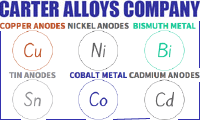
-----
Phosphorized vs. OFHC Copper Anodes for copper plating
Q. Phosphorized or OFHC Copper Anodes. Do these two types of anode formulations respond differently to different Copper plating bath chemistries? Should one be used for sulphate, one for Cyanide, etc, and what problems will be brought about by using the wrong one?

Dave Kinghorn
Chemical Engineer
SUNNYvale, California
1997
A. Hi dave.
Amax Copper [Greenwich, CT] has flyers on both Phosphorized and OFHC copper anodes that explain in a good bit of detail where they perceive each to be best and why. When they sent me an info packet, it included reprints of a couple of articles on the subject. From a quick glance it looks like phosphorized are suggested for copper sulphate ⇦ on eBay or Amazon [affil link] because the phosphorous decreases the anode efficiency, minimizing copper buildup.

Ted Mooney, P.E.
Striving to live Aloha
finishing.com - Pine Beach, New Jersey
Ted is available for instant help
or longer-term assistance.
1997
Q. Let me rephrase it: We have all read the process technical data sheets specifying the anode types called out for various chemistries. The question is "why". Why does one anode formulation respond differently than another when exposed to various chemistries and can these differences be exploited in different ways? For example could the anode efficiency be "tuned" by mixing anode types in the baskets? For high speed plating can P build up in the bath? Does one type withstand higher current density demands than another? These "what-if's" are important questions to ask when designing high-speed processes for electronics/aerospace applications.
Regards,

Dave Kinghorn
Chemical Engineer
SUNNYvale, California
A. Lowenheim's "Modern Electroplating" ⇦[this on eBay , Amazon, AbeBooks affil links] covers SOME of the reasons for anode choice on pages 180, 192 and 210; cyanide, acid and pyrophosphate solutions respectively.
James Watts- Navarre, Florida
1997
A. Thanks for the research, James. Indeed, Modern Electroplating seems to have a very good treatment of the subject. The short answer is that non-phosphorized anodes dissolve too fast in acid copper, causing excessive loss of particles, and high copper concentration and consequent 'polarization' (when the copper concentration near the anode gets too high, apparently there is no longer enough ionization, so current does not flow as well as it should). Dave may hopefully be able to employ these facts in a way helpful to his development efforts.
Luck & Regards,

Ted Mooney, P.E.
Striving to live Aloha
finishing.com - Pine Beach, New Jersey
Ted is available for instant help
or longer-term assistance.
Q. Question from the previous letter --
Which type of Copper Anode is used for the Acid Copper Plating Bath, Phosphorous or Electrolytic? Can anyone please give me the following: SOURCE of ANODE & ANODE BAGS?
Ed Cherney1999
A. Hi Ed
Phosphorized anodes are recommended for acid copper (to reduce growth of copper concentration in the solution, I believe); but talk to the supplier referenced above or to Carter Alloys Company [a finishing.com supporting advertiser] or Tally Metal Sales about this, and for sourcing of anodes and anode bags.
To the extent practical we try to avoid sourcing discussions on this site ( huh? why?)
Ted Mooney, P.E.
Striving to live Aloha
finishing.com - Pine Beach, New Jersey
Ted is available for instant help
or longer-term assistance.
1999
Multiple threads merged: please forgive chronology errors and repetition 🙂
Q. Dear sirs:
I would like to know if there is any disadvantage in using phosphorized copper anodes (0.04-0.06 phosphorous) in a cyanide copper bath instead of electrolytic or oxygen free copper anodes?.
Thanks in advance for your advice.
Oscar Infante- Santiago, Chile
A. I think one major disadvantage is phos copper anodes cost more. Maybe someone more experienced than I will know of plating disadvantages. Don't think there are, not sure.
Bill Hemptech svc. w/ chemical supplier - Grand Rapids, Michigan
Q. I have discontinued my acid copper sulphate bath. I have around 1,000 lbs of phos-copper anodes that I used in this process. I also have a couple of generic cyanide copper strike and plate tanks. I was wondering if I could use my phosphorus doped anodes in my cyanide baths. I am currently using oxygen free anodes in the strikes. The cyanide anode bags aren't bagged. I can sell the phos-Cu anodes if need be, but it would be a lot easier to use them up in-house.
Regards,

Trent Kaufman
electroplater - Galva, Illinois
2004
A. Trent, No you can't not use them.
Regards,

Anders Sundman
4th Generation Surface Engineering
Consultant - Arvika,
Sweden
Q. We use oxygen free copper anodes in cyanide copper strike bath and phosphorised copper anodes in acid copper bath.
Now we've stopped the cyanide copper bath, can I use the balance of oxygen free copper anodes in the acid copper bath?
If the answer is yes, what kind of treatment do I need to do before apply the oxygen free copper anodes in acid copper bath.
thanks!
Plating Shop Employee - Malaysia
October 11, 2010
Ed. note: Reading your posting and Trent's equal & opposite one, it sounds like the world really needs waste chemical exchanges :-)
Q. What will happen if I use phosphorised copper anodes in cyanide copper plating, besides anode corrosion.
Sanjay Shinde- Mumbai, Maharashtra, India
March 29, 2012
Q. We have a copper cyanide bath that has phosphorous contamination. One of the operators inadvertently added phos copper nuggets to the anode basket. The phosphorous content is around 300 ppm. We have brittle deposit from this bath. Has anyone encountered this problem?
Vijay Merchant- Los Angeles, California, USA
February 19, 2013
Ed. note: And there's Sanjay's answer :-)
Q. Hi all,
I work in an electroforming shop, and recently we were dissecting old anode baskets for our pyrophosphate copper and acid copper baths. Unfortunately, they were not marked with the type of copper contained in the anode basket. Until recently, the shape of the material was indicative of the type, but that has changed.
Is there a test to determine if the copper is oxygen free vs. phos?
Thanks in advance,
- Rochester, New York
September 5, 2013
A. Brian,
If I understand the question correctly, one way to check is to heat treat. Oxygen-free copper will be clean and shiny after h.t., other copper will not be even if polished with a wire brush, etc.

Blake Kneedler
Feather Hollow Eng. - Stockton, California
Q. Blake,
You did understand the question, and thank you very much for your response. What temp should I heat treat the copper at? Should I prepare the copper at all before I do this?
Thanks again,
Brian
- Rochester, New York
September 9, 2013
adv.: Supplier of Copper Anodes, Nickel Anodes, Bismuth Metal, & Other Metal Products for Industry & The Arts

Q, A, or Comment on THIS thread -or- Start a NEW Thread